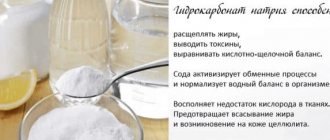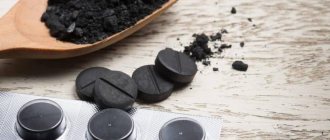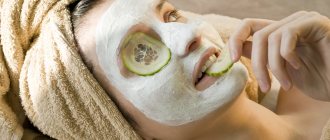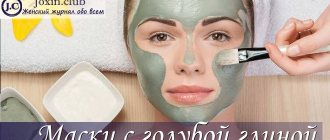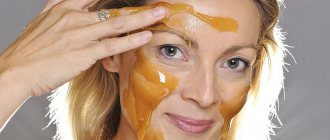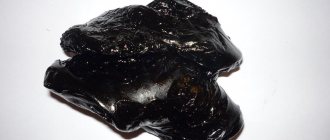Despite the huge range of branded creams, natural and simple cosmetics that are easy to make yourself at home still remain relevant. A striking example of an effective product is white clay for the face: the properties of this product are indispensable for restoring and maintaining the firmness and elasticity of the skin. One of the proofs of the popularity of this product in cosmetology is its versatility; face masks made from it are suitable for women with different skin types; all that is important is the correct selection of recipes and the frequency of procedures to obtain the desired effect.
Properties of white clay
Masks made from white clay, or kaolin, as this substance is also called, are popular in cosmetology and are used as care products for oily facial skin, as well as for the treatment of acne. White clay is a natural mineral, and its basis is made up of compounds of aluminum and silicon oxides, the so-called aluminosilicates.
Clay, which is used in cosmetology, has a lot of useful properties:
- Drying the skin - used to remove secretions from sweat glands and subcutaneous sebum.
- The cleansing effect is an ideal product for soft, delicate peeling of the facial skin.
- Absorbing effect - small particles of clay help remove harmful substances and toxins not only from the skin, but also from the human blood.
- Good thermal conductivity makes it possible to use it not only in cosmetology, but also in folk medicine.
Compound
The structural formula of the breed includes the following useful elements:
- Silicon, which promotes collagen production. Responsible for restoring and maintaining the elasticity of the skin.
- Aluminum with a drying effect. Provides elimination of excess oily shine.
- Manganese, which has a disinfectant effect. Eliminates inflammation, accelerates the healing of ulcers.
- Calcium, which returns natural tenderness to the epidermis. Helps restore elasticity.
- Potassium, which regulates cellular water balance. Helps moisturize the skin, eliminate dryness and flaking.
- Copper, which enhances defense mechanisms. Allows you to preserve the natural shade of hair and skin.
- Zinc, which is a natural antioxidant. Rejuvenates and dries the skin.
The unique composition of white clay determines an extensive list of beneficial properties of the product. Silica (silicon dioxide) contained in kaolin is a basic component. It has the ability to stimulate the body's absorption of various microelements.
The main ingredient used in sculpting white polymer clay is polyvinyl chloride.
Indications and contraindications for white clay masks
It is advisable to use white clay in the following cases:
- acne on the face;
- black dots;
- inflamed facial skin;
- age-related changes - facial wrinkles, age spots, other signs of premature aging;
- violation of the secretion of the sebaceous glands.
There are no contraindications to the use of kaolin, since it is a natural material. Clay is absolutely safe for humans and cannot cause harm to health. When choosing to use store-bought masks based on white clay, carefully look at what else is included in the composition. Many substances, such as honey and nuts, can cause an allergic reaction.
It is strictly forbidden to apply clay if there is damage to the skin - wounds, scratches. This can cause itching and irritation and lead to inflammation. To test your skin's sensitivity to the product, apply a small amount to the crook of your elbow.
Remember that women with dry sensitive skin should not overexpose the mask. You can’t wait until the clay completely dries or the time according to the instructions runs out.
Mechanism of action
White clay has a complex effect on the skin:
- absorbs - kaolin helps eliminate toxic substances;
- bactericidal and antiseptic - the product helps prevent the development of bacteria, inflammation, fungal diseases;
- increases heat capacity - kaolin retains heat, when using a mask it helps to relax folds and smooth out wrinkles
- dries - eliminates acne, evens out skin structure, prevents inflammation, regulates the functioning of the sebaceous glands;
- whitens - suitable for reducing the severity of freckles, excess pigmentation, eliminates redness;
- moisturizes - kaolin, unlike yellow, green, blue clay, does not dry out the dermis and regulates hydrobalance;
- regenerates - renews the epidermis layer, enhances the formation of new cells;
- cleanses - suitable for gentle care, smoothing the skin structure, tightening pores, removing toxins.
White clay mask for different skin types
A white clay face mask is suitable for any skin type without exception. Although here the opinions of dermatologists differ somewhat. Most experts insist that this substance is most suitable for women with oily and combination skin, while those with dry and sensitive skin should still choose a more gentle means for personal care.
There are no other contraindications, and it is worth remembering that white clay can be used for all skin types if the ingredients included in its composition are selected correctly.
For example, if, in addition to kaolin, the product contains moisturizing oils, grape, argan and others, it can also be used on dry skin. These substances will compensate for the drying effect that the clay creates and will not cause harm.
Don't miss the most popular article in the section: Amaranth oil - properties and use in cosmetology, reviews, price of the product.
Reviews
Olga, 29 years old, Moscow: “I regularly add cosmetic clay to masks, the product helps even out skin tone, eliminate greasy shine, and cleanse pores. I mix kaolin with oils and fermented milk products, because... dry skin."
Elena, 40 years old, Krasnodar: “I went through a complex of restorative procedures with the addition of kaolin, honey and starch. The severity of wrinkles has decreased, the complexion has improved, the dermis has acquired elasticity and a toned appearance. After the break, I plan to continue using the treatment complex.”
Rules for preparing white clay face masks
The rules for preparing masks at home are quite simple:
- Use only glass or ceramic dishes for cooking. A metal bowl will not work, because the minerals that make up the clay can react with the metal and lose their beneficial properties.
- It is best to dilute clay with boiled water. But not hot, but slightly warm. The consistency of the resulting substance should resemble sour cream.
- Before applying the mask, first cleanse your face. It is better to leave the area around the eyes untouched.
- Apply the mask immediately after preparing it. Later it will harden and the moisture will evaporate from it. This will make it unusable.
- Never do the procedure if your facial skin is very irritated. This can cause itching and severe inflammation.
- Do not use a white clay mask more than once or twice a week. After carrying out 10 such procedures, cosmetologists recommend taking a break for about a month. If desired, the course can be repeated later.
Effect of use
When used externally, the material has the following positive effects on the skin:
- relieves inflammation and irritation of the dermis;
- mattifies the skin;
- eliminates excess shine, regulates the functioning of the sebaceous glands;
- absorbs toxic substances;
- tightens enlarged pores;
- improves complexion;
- lightens pigmentation;
- evens out the contour of the face;
- eliminates puffiness and adds elasticity;
- improves metabolic processes in epidermal cells;
- eliminates peeling;
- smoothes wrinkles, launches rejuvenation and regeneration processes.
Popular recipes for masks with white clay at home
The popularity of masks with white clay at home is explained by the ease of their preparation and the excellent effect of their use. They do not take much time, and the result will not be long in coming.
What are the most popular masks among women today? Firstly, a standard mask with clay, milk and starch, and secondly, masks with the addition of various products. This can be honey, lemon juice, and also calendula, which gives a good antiseptic effect. The addition of string, cabbage leaf, and sea buckthorn oil will cleanse the skin.
There are a huge number of mask recipes, so you can choose those that you like best and add those components that are available in the refrigerator or home medicine cabinet.
Recipe for a classic white clay mask
To prepare a face mask according to the classic recipe, you need to take white clay, which is also popularly called porcelain clay, because of the pure and radiant color of this substance.
Method of preparation: white clay purchased at the pharmacy should be diluted in lukewarm water and applied to the face for 8-10 minutes. After this, rinse with water and apply moisturizer to the skin. Instead of water, clay can be diluted in milk or herbal decoction.
What effect will we get: whitening, getting rid of oily shine and cleansing the skin.
Anti-inflammatory mask for healthy skin
A white clay face mask can also have an anti-inflammatory effect. Dermatologists usually talk about the benefits of black, green and blue clay, but porcelain (white) clay can also remove redness and acne on the skin.
You can make an anti-inflammatory mask based on kaolin, dried linden and nettle. As an active element, it is also good to add vitamin E in capsules.
We buy all the ingredients at the nearest pharmacy and then mix them in the following sequence:
- Take 10 grams of dried linden and nettle and pour boiling water over it. Let it sit for 30 minutes.
- The resulting herbal infusion needs to be filtered and cooled slightly until it becomes lukewarm.
- Pour the herbal decoction into a glass container and add 30 grams of vitamin E.
- Add 20 grams of kaolin and mix thoroughly.
- Apply the prepared porridge for 20 minutes and then rinse thoroughly.
Deep cleansing mask
To cleanse your face well with white clay, you need to know a few secrets:
- You need to first open the pores on your face using steam herbal baths. Chamomile and sage work best. Or just wash with hot water.
- Apply the mask only to clean skin.
- Before using the mask, apply a scrub to your face to remove dead cells.
- After washing off the mask, you need to close the pores: apply any moisturizer to them.
Remember that deep cleaning should be done no more than once a week. This can be done not only in the salon, but also at home.
For example, with this remedy: Mix a spoonful of clay with miramistin and chlorhexidine and stir into a paste until smooth. Apply this composition for no more than 20 minutes.
White clay mask for face whitening
A white clay mask is ideal for whitening your face. You can achieve the maximum effect and lighten your skin by 2 tones by adding fruit and vegetable juice to the composition. The most popular and effective are cucumber or lemon juice. With this product you can not only cleanse and moisturize the skin, but also relieve inflammation and irritation.
How to cook:
- take several large cucumbers;
- grate or extract juice from them;
- mix with two tablespoons of white clay;
- spread on face and leave for 15 minutes;
- Wash thoroughly after use.
The prepared mask can be stored in the refrigerator for 8 hours. Suitable for all skin types. And instead of tap water, you can use mineral water when rinsing off, which will create an additional tonic effect.
Universal rejuvenating white clay mask
To obtain a rejuvenating effect, you can dilute white clay in milk. It is not for nothing that the beauty recipe of Queen Cleopatra, who, according to legend, loved to take milk baths, has survived to this day. It is milk that rejuvenates both the body and facial skin.
A mask with white clay and egg gives an excellent rejuvenating effect.
Aloe juice, which can increase the vital activity of cells, will also help give the skin a rejuvenating effect. The popularity of this recipe is also explained by the fact that this plant grows in many homes, or on the windowsills of beloved grandmothers.
Aloe leaves must first be cut, washed well and put in the refrigerator. Ideally, they will lie there for 10-14 days.
It is better to choose thick and fleshy leaves; more juice and pulp can be extracted from them. Why put them in the refrigerator? Yes, simply under the influence of low temperatures and darkness, aloe will produce special biological stimulants, which will give the effect of skin rejuvenation.
Then everything is simple - you need to mix the juice and pulp extracted from the flower with white clay, and after 20 minutes enjoy the result.
White clay face mask with tea tree
There is such an interesting recipe with the addition of tea tree extract.
You need to take a tablespoon of clay and half a teaspoon of salicylic acid. Next, you need to pour in tea tree essential oil (3-4 drops, no more!) and 3 tablespoons of water. You can use boiled or mineral water.
To properly prepare the mask, first mix clay and salicylic acid. Next, add the oil and rub in a ceramic container until the lumps disappear. Water should be added last.
Naturally, you must first remove makeup from your face and cleanse your skin. The maximum time for which the mask can be applied is 20 minutes. However, the first time you use it, it is better to cut it in half. It is recommended to carry out the procedure no more than 2-3 times a week.
How to make a white clay mask with lemon
Adding lemon juice to masks gives them a whitening effect and even smoothes out annoying wrinkles.
To prepare the mask you need:
- Take white clay and one small lemon.
- Press 3 drops of lemon juice into the prepared container and add 1.5 tablespoons of clay.
- Add a little water and dilute the resulting mixture to a paste.
- You can use a mask.
The approximate time for which you need to keep this whitening mask is 10-11 minutes. It is better to wash it off with slightly cool water. You can add gruel of finely grated cucumber to the mask. This component will refresh the skin and also give it a whitening effect. Cosmetologists recommend making such a mask once every 3 days.
White clay face mask with milk
A white clay face mask can also be added with fresh milk. The product can be either homemade or store-bought, pasteurized. This product will help rejuvenate the skin, get rid of dryness and improve its condition. Therefore, this mask is well suited for dry skin types.
After use, the skin will receive gentle hydration and additional nutrition, and the signs of aging will disappear for a long time.
Making this mask at home is easy and simple:
- Take three spoons of cow or goat milk.
- Add a tablespoon of homemade cottage cheese or sour cream.
- Mix the dairy products thoroughly with a tablespoon of white clay.
- You can apply the paste to your face for 20 minutes.
Nourishing face mask: white clay and honey
The product can remove excess wrinkles and age spots, tightens the skin well and gives it freshness. For preparation you only need honey and clay.
Cooking method:
- Heat a teaspoon of bee honey in a water bath until the honey becomes completely liquid.
- Add a tablespoon of clay, pouring it into the honey in small portions.
- The mixture must be brought to a creamy consistency.
- We wait until the mask cools down a little so as not to burn your face, and then apply it for 20 minutes.
This mask is suitable for women with oily skin. Another variation could be a mask made of honey, kefir and clay. The preparation method is the same, you just need to add a little kefir or whey to the composition.
An interesting option for a mask that is suitable for dry skin types is milk, honey, clay and a couple of drops of almond oil.
How to make a white clay face mask with oils
By enriching your facial care product with essential oils, you can create a real spa at home. By choosing the right components, it is easy to clean pores, remove inflammation, or, conversely, moisturize the skin.
It is better to buy essential oil not in a cosmetics store, but in a pharmacy. No more than 3-4 drops of any oil should be added. Then the remedy will bring benefit, not harm.
To make a clay mask with added oil you need:
- Mix all components (except kaolin) in the selected container.
- After this, add the liquid ingredients to the clay and stir until the lumps disappear.
- Apply to skin.
The base liquid can be boiled water, juice, yogurt or herbal decoction. It is advisable to use a mask with the addition of essential oil immediately after preparing it. But if the need arises, it can be stored in the refrigerator for up to 2 days, tightly closing the container.
With protein and salt
An interesting way of using food surprises all people. In this case, each component has a great effect on the skin, performing the main task - whitening the integument. The mask recipe is not that complicated:
- Take one egg white and beat it.
- Add a pinch of salt and beat the mixture again until foam appears.
- Pour half a tablespoon of dry clay into the resulting mass and mix again.
- Apply the mask to your face and leave for about 15 minutes.
- Rinse your face thoroughly and gently with running water.
- Treat the skin with a cream (store-bought or homemade) with a moisturizing and nourishing effect.
How to properly apply clay masks to your face
By following a few simple rules when using clay masks, you can avoid many skin problems.
What you need to know:
- When buying ready-made masks, carefully read their composition. Eliminate those components to which you may be allergic.
- Test the mask on the crook of your elbow before applying it to your skin.
- If there are any problems with your facial skin, it is better to first visit a dermatologist.
- Do not dilute clay in boiling or hot water. The water should be room temperature.
- Before using the mask, you need to cleanse your face with your usual scrub and take a steam bath.
- Do not apply a clay mask to the skin around your eyes.
It is important to apply the mask along massage lines. - It is better to wash off the mask with lukewarm water.
- Do not do the procedure more than 1-2 times a week.
- Remember that the course of using white clay should not exceed 10 masks. After this, cosmetologists insist on a break for at least 2 weeks.
With lemon and cucumber juice
A rather unusual recipe gives quite a good effect. Although at first glance this mixture seems completely ineffective, after the first session anyone can be convinced of the opposite. To prepare the composition you need:
- Combine a tablespoon of the main ingredient with a few drops of lemon and cucumber juice.
- Mix the mixture thoroughly and apply to previously cleansed skin.
- After 10 minutes, rinse your face with warm water.
- Dry the skin with a soft towel and apply a moisturizing cream to it.
How long to keep a white clay mask on?
A white clay face mask can be an excellent way to tighten and rejuvenate the skin. But here it is important not to overdo it and not to leave the mask on longer than it should be.
The first thing to remember is that in case of any discomfort, burning, or itching, remove the product immediately! Don't wait the required 5, 10 or 15 minutes. Perhaps you have a rare allergic reaction or individual intolerance to some component of the drug, which you had not previously thought about. The effect of slight skin tightening does not apply here.
Do not forget that no mask should completely dry on your face if it contains clay.
The time of the procedure depends on the skin type. For those with oily skin, it will be 20 minutes. For normal skin – 10, and accordingly for women with dry skin it is better not to keep the clay mask on for more than 5 minutes.
Classic
The standard version of the mask is ordinary dry clay combined with water. To do this, you will need to mix these two components so that you get a creamy consistency. The most important thing is to stir the lumps. Components should not be taken in large quantities, as they will be wasted. For one procedure, only a couple of teaspoons of the main ingredient and 2-4 spoons of water will be enough.
The mask is applied to a clean face and left until it becomes lighter and begins to crack. It should be washed off with running water. After the procedure, you can treat the skin with a nourishing or moisturizing cream, depending on the type of skin.
How often can you make masks from white clay?
Experts prohibit making clay masks too often. Even women with oily skin are recommended to apply clay no more than twice a week. If your skin type is normal or combination – no more than once. For dry skin, dermatologists recommend using white clay no more than 2 times a month.
Photos before and after a course of masks with white clay.
This is due to the fact that clay, for all its beneficial properties, dries the skin and draws out its moisture. You can overdo it with treatments and deteriorate your skin health.
White clay masks are beneficial for the face. But using them too often can have the opposite effect. Follow all the recommendations and mix the components strictly according to the instructions, and then you will get the effect of salon treatments at home.
With soda and talcum powder
Whitening clay also works great when combined with talcum powder and baking soda. To prepare and use the composition, you must proceed in stages:
- Take a tablespoon of the main component - clay, and mix with 1.5 teaspoons of soda and half a dessert spoon of talc.
- Mix thoroughly and add a couple of drops of hydrogen peroxide.
- Having achieved a uniform consistency, apply the resulting mixture to your face, avoiding restricted areas (eyes, nostrils and mouth).
- After 15-20 minutes, wash with warm water.
- Dry the affected skin a little and apply a cream with an oily base.
No other products should be used after the procedure for two hours. This is explained by the fact that their effect can slow down or completely block the effectiveness obtained from a clay mask.
